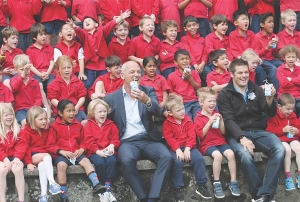But it was an important part of the strategy because milk consumption among children had been dropping, he said. That meant the children were not getting the health benefits of milk and Fonterra faced missing out on the next generation of consumers.
When he first came to the cooperative the public was concerned about waterways pollution and milk for children in schools. The co-op has addressed both, but Spierings sees Milk for Schools as the “jewel in the crown”, delighting in the scheme being rolled out nationwide as he had pushed for it. But he did not want the limelight on Fonterra management, instead he wanted credit for farmers as providers of the milk for children.
At the launch of the scheme at Three Kings School, Auckland, Spierings said he was passionate about child nutrition. Fonterra had about 10,500 farmers and about 1000 schools getting milk in the scheme. That equated to about 10,000 children, so each farmer was providing milk to about 10 children.
“That’s connecting the beginning and end of our supply chain,” he said, a link connecting communities and building pride in New Zealand. “When I came [to Fonterra] I said I want to make milk accessible, affordable and available because we are the biggest in the world and if we don’t feed our own children properly, that’s absolutely unacceptable.”
Fonterra also wanted to protect the waterways of New Zealand. They now had 100% of all the waterways mapped and 85% fenced – a doubling of what it was 15 months ago.
“We would like to ask children – after they get Milk for Schools – to help our farmers put plants around the waterways,” he said. “That will be our next step.”
Three Kings Primary School principal Josephine Wilmoth said getting their first delivery of milk from Richie McCaw was a highlight of the year.
“Signing up for Fonterra Milk for Schools was an easy decision. It allows us to provide our children with great nutrition that will support their learning,” said Willmoth.
McCaw, a Fonterra ambassador, says Fonterra’s long-term investment in the health of New Zealand’s children will benefit kids in years to come. He was advised by a nutritionist to drink milk daily to achieve optimum health for rugby training.
Milk for Schools is now in 11 regions from Northland to Southland, reaching Auckland last week. Eventually at least 1300 schools will get the milk. Auckland will have the most, 130, all enrolled by the end of term one 2014.
















